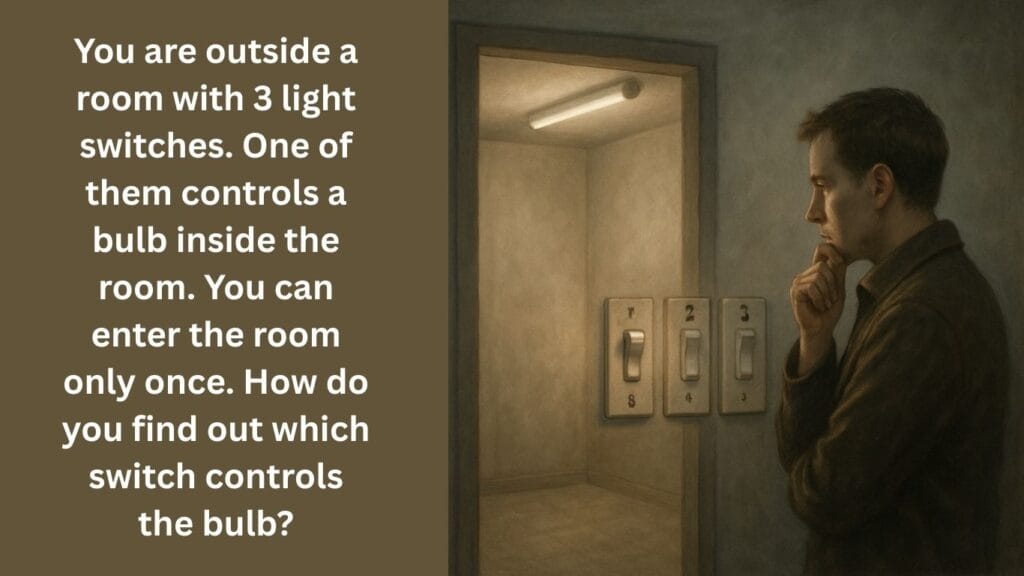You are outside a room with 3 light switches. One of them controls a bulb inside the room…
Question: You are outside a room with 3 light switches. One of them controls a bulb inside the room. You can enter the room only once. How do you find out which switch controls the bulb?

Let’s solve this by understanding the Problem
We have three switches outside a room, and only one of them controls a single bulb inside the room. We can manipulate the switches as much as we want, but we can only enter the room once to observe the bulb. After this single observation, we need to be able to definitively say which switch controls the bulb.
At first glance, it seems impossible because flipping a switch and entering the room only gives us information about the current state of the bulb (on or off) for that particular switch’s position. But since all switches look the same from the outside, how can we distinguish between them with just one observation?
Initial Thoughts
If I flip a switch and enter the room:
- If the bulb is on, then the switch I just flipped controls it.
- If the bulb is off, it could be either of the other two switches.
But this doesn’t help me distinguish between the other two switches if the bulb is off. I need more information from that single observation.
Considering the Bulb’s Properties
The key here is to realize that a bulb, when it’s on, produces heat. An incandescent bulb (which is likely the type implied in this puzzle since LEDs don’t get as hot) heats up when it’s on and cools down when it’s off. This temperature change can be an additional source of information beyond just the bulb’s current state (on/off).
Developing a Strategy
Here’s how we can use the bulb’s heat to our advantage:
- Turn on the first switch and leave it on for about 5 minutes. This duration is enough for the bulb to heat up if it’s the one controlled by this switch.
- After 5 minutes, turn off the first switch and quickly turn on the second switch. Now, immediately go into the room to observe the bulb.
Analyzing the Observations
Now, based on the bulb’s state and temperature, we can determine which switch controls it:
- If the bulb is on: Since the second switch is the one currently on, and the bulb is on, this means the second switch controls the bulb.
- If the bulb is off but warm: The bulb was on long enough to heat up (controlled by the first switch) but is now off because we turned the first switch off and the second switch doesn’t control it (since the bulb is off now).
- If the bulb is off and cold: Neither the first nor the second switch controls the bulb. The first was on but turned off (no heat), the second is on but doesn’t control it, so the bulb must be controlled by the third switch, which was never turned on, hence the bulb is off and cold.
Step-by-Step Solution
Let’s summarize the steps clearly:
- Turn on Switch 1: Leave it on for about 5 minutes. This allows the bulb to heat up if it’s connected to Switch 1.
- After 5 minutes, turn off Switch 1: Immediately turn on Switch 2. Now, Switch 2 is on, and Switch 1 is off. Switch 3 remains off the entire time.
- Enter the room to observe the bulb:
- Bulb is on: This means the current active switch (Switch 2) controls the bulb.
- Bulb is off but warm: The bulb was on (heated by Switch 1) but is now off, so Switch 1 controls it.
- Bulb is off and cold: The bulb was never turned on, so Switch 3 controls it.
Why This Works
This method utilizes both the electrical state (on/off) and the thermal state (warm/cold) of the bulb to gather more information from a single observation. Here’s the reasoning behind each scenario:
- Switch 2 controls the bulb: It’s the one currently providing power, so the bulb is on.
- Switch 1 controls the bulb: It was on long enough to heat the bulb but is now off, so the bulb is off but retains heat.
- Switch 3 controls the bulb: Neither Switch 1 (now off) nor Switch 2 (on but not controlling) has powered the bulb, so it’s off and never heated up.
Potential Missteps
Initially, one might think to flip switches and check the bulb’s state without considering the heat, leading to ambiguity between two switches when the bulb is off. Another mistake could be not leaving the first switch on long enough for the bulb to heat up sufficiently. Ensuring the bulb has time to warm up is crucial for the thermal clue to be effective.
Final Answer
To determine which of the three switches controls the bulb with only one entry into the room, follow these steps:
- Turn on the first switch and leave it on for about 5 minutes. This allows the bulb to heat up if it’s connected to this switch.
- After 5 minutes, turn off the first switch and immediately turn on the second switch.
- Enter the room to observe the bulb:
- If the bulb is on, then the second switch controls it.
- If the bulb is off but warm to the touch, then the first switch controls it.
- If the bulb is off and cold, then the third switch controls it.
This method effectively uses both the bulb’s current state and its temperature to identify the correct switch with a single observation.

